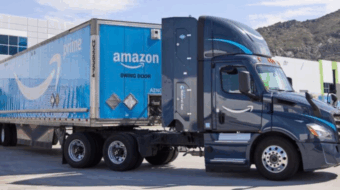
EAST PALESTINE, Ohio—U.S. rail unions and the AFL-CIO Transportation Trades Department have by and large agreed with federal safety findings as a result of the East Palestine, Ohio, freight train derailment disaster early in 2023. But there are some holes.
A reading of the National Transportation Safety Board’s summary report shows the top one is no mention of railroads’ one-third cut in the number of freight train workers, including trained safety inspectors, starting in 2015. Unions and workers have battled those cuts ever since.
The railroads cut workers, shifting to automation instead, to satisfy the greed for higher dividends and other payouts to their Wall Street investors. As a result, safety went south.
“The National Transportation Safety Board’s findings and safety recommendations are an indictment of widespread safety failures across the freight rail industry,” Transportation Trades Department President Greg Regan said.
“The board identified a number of key safety issues thematic to the industry, including a lack of federal standards for the use of wheel bearing defect detectors, communications delays during emergency responses to rail accidents or incidents, and vulnerabilities of aging tank cars that carry hazardous materials.
“As the eyes and ears on the ground, rail workers have diligently raised the alarm about these kinds of existing safety deficiencies and many others.”
In a polite but pointed criticism of the rail lobby and the railroads, NTSB Chair Jennifer Homendy said, “Unfortunately, some have sought to minimize the wide-ranging impacts of this derailment, pointing to the fact that there were no fatalities or injuries. For this, we are certainly grateful, but the absence of a fatality or injury doesn’t mean the presence of safety.
“Our agency doesn’t wait for death or injury to occur. Instead, we objectively analyze the facts and evidence to make recommendations that, if implemented, will ensure this never happens again. Thanks to the hard work of our world-class investigators, we now have a roadmap to do just that.”
The board recommended federal regulators order railroads to institute “minimum standards to protect railroad workers and the public” from the effects of a bearing and axle failure “and minimum requirements for the installation, inspection, and maintenance of wayside bearing detectors,” Regan said.
The feds should “establish rules governing railroads’ operational responses to bearing alerts and alarms, update existing guidance for vent and burn procedures, and exercise regulatory authority” to force the rail lobby and its member railroads to get the aging and leaky tank cars which produced the East Palestine disaster off the rails for good.
The NTSB summary, released at a public hearing in East Palestine High School, covers only the mechanical problems that led to the Norfolk Southern disaster there—and to a wrongheaded decision to immediately release toxic chemicals from the derailed tank cars.
That total release was unnecessary, NTSB told the crowd. Removing the toxins could have occurred gradually and safely. Instead, the chemicals befouled the water supply, killed thousands of fish in the river that flowed through town and sent a mushroom cloud looming over East Palestine.
“The decision by the local incident commander three days later to conduct a vent and burn of the contents of the tank cars carrying vinyl chloride monomer was based on incomplete and misleading information by Norfolk Southern officials and contractors. The vent and burn was not necessary to prevent a tank car failure, NTSB investigators found,” the board said.
“According to the Federal Railroad Administration, a vent and burn procedure should be a last resort, used when a tank car is about to fail,” it adds.
A second major hole is the report cites mechanical failures, notably the overheating of an axle on one freight car, which snapped, sending that Norfolk Southern car and others off the tracks, where the fire started. The NTSB also cites a lack of trackside sensors to monitor the cars and their axles as the long freight rolled by on that frigid winter day.
NTSB added the railroad freight industry’s standard for triggering alarms about overheating is too high. Different railroads have different triggers. Norfolk Southern’s trigger—an axle temperature of 200 degrees Fahrenheit more than surrounding air—is one of the lowest.
The alarms went to the railroad’s central safety officer, sitting at a computer miles away, and from there to the engineer and conductor, too late. That’s a flaw, too, NTSB said.
NTSB is silent on the railroads’ cuts in their workforces by one-third in the last decade. The unions, the Transportation Trades Department, and Railroad Workers United, a rank-and-file group that includes members of all 14 rail crafts, say the carriers do so as part of their drive to put profits before people. That satisfies Wall Street financiers while compromising safety.
A critique issued June 24 by one union, Smart’s Transportation Division, said the rail lobby, the Association of American Railroads, also tried to worsen safety procedures by computerizing all hazardous materials safety reports and sending them to a central site. SMART is the largest railroad operating union in North America, with more than 500 Transportation Division (TD) locals.
The union advocates for continued physical, paper reports and for putting them in the hands of engineers, conductors, and first responders. It defeated that industry push.
“This might not sound like a big deal, but it absolutely is,” said Smart-TD President Jeremy Ferguson. “The safety of our members and the community often hinges on access to this hazmat paperwork and the professionalism of our people to know how to apply the information.
“Anyone willing to tell you a tablet and WiFi is adequate to depend on in a high-stakes crisis involving hazmat doesn’t have the public’s best interest or the physical safety of railroaders in mind…Smart-TD’s members continue to be the most reliable variable in cases of emergency.”
NTSB called overheated wheel bearings “a common cause of rail accidents. Hot bearing detectors are part of a system intended to warn crews to stop the train before the hot bearing can cause a derailment.
“The crew did not receive a hot bearing warning until the train passed over a detector in East Palestine when the overheated bearing was about to cause its axle to fail.” The Norfolk Southern freight had begun its eastward run in the middle of Illinois. “The crew began to slow the train using dynamic braking, but it was too late. A total of 38 rail cars derailed, including 11 rail tank cars carrying hazardous materials.
“The difficulty of accurately measuring temperature inside the bearing, combined with Norfolk Southern’s standard operating procedures and the spacing between detectors, meant the crew did not receive adequate warning to stop the train before the derailment,” NTSB said.
We hope you appreciated this article. At People’s World, we believe news and information should be free and accessible to all, but we need your help. Our journalism is free of corporate influence and paywalls because we are totally reader-supported. Only you, our readers and supporters, make this possible. If you enjoy reading People’s World and the stories we bring you, please support our work by donating or becoming a monthly sustainer today. Thank you!










